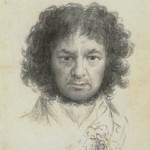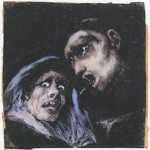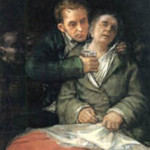The work of the Spanish master, Francisco de Goya y Lucientes (1746-1828), is so richly diverse and complex, that depending upon what is sampled, it is possible to present him as the progenitor of just about any modernist argument. Is he rooted in the Romantic Rebellion of the late 18th and early 19th century? A Humanist of the Enlightenment that evolved from the Age of Reason and the Age of Revolution? Is he a satirist and social commentator in the tradition of such authors as Voltaire and Swift? Perhaps he anticipates surrealism in his evocation of the horrific and nightmarish. Or, is he expressing the visions of the satanic and anti Christ? Certainly, he is the founder of political art and dissent. Arguably, his disdain for academic refinement and detail casts him as the beginning of expressionism particularly in his relentless experimentation in the application of paint and works in lithography. He is regarded as the greatest graphic artist of his era. Or, was he simply mad, driven so by devastating illness that left him stone deaf, and the uncertainties of being caught up in the terrible political turmoil of a conservative monarchy and the struggles of liberalism in the disaster of Napoleonic occupation.
The pure joy of this relatively small, precious and concise exhibition “Goya’s Last Works” organized for the Frick Collection by Jonathan Brown and Susan Grace Galassi, through May 14, is that it presents a sharply focused, riveting view of the final days of a great and much tormented master. This precisely limited project concentrates on a few paintings, a number of drawings, several lithographs, and the remarkably original and inventive series of experimental paintings on small rectangles of ivory. Often, larger exhibitions and surveys of the oeuvre get mired and confused by the daunting challenge of sorting out the diversity of critical and historical approaches that the work enables. Too often, the curator or author has a point to make independent from the work itself. This exhibition appears to avoid that process by setting forth a rational catalogue that combines lucid biographic and historical sketches with very meticulous catalogue entries for the remarkable works presented.
Not surprisingly, the exhibition is being widely regarded as the gem of the season and surely its most important historical project. Accordingly, the museum was quite crowded on a weekday afternoon when we visited. The tickets were for entry an hour from our arrival time so we used the opportunity to revisit a collection that is not often on our itinerary. Truth is, the Frick’s special exhibition galleries are an afterthought in the historic mansion that houses a magnificent private collection. The basement galleries are relatively small and not suited for large works. The great collectors, in their house museums, never anticipated the needs of modern institutions. So these galleries are carved out of areas that originally had other functions. That said, a visitor soon lost all sense of surrounding as we pressed forward to examine intently an array of intimately scaled works. The tiny works on ivory, in particular, pulled us in with their intensely and brilliantly worked luminescent surfaces and horrific grotesque subjects that recall the monstrosities of the Black Paintings mounted in the basement galleries of the Prado Museum in Madrid.
The exhibition concentrates on the production of the artist when he was living more or less in exile as a member of an expatriate community of Spanish liberals in the French city of Bordeaux. He was officially allowed to leave the service of the king to seek the cure of spa for his various ailments. Despite failing health the artist visited Paris and commuted to Madrid several times on business. His time in France is described as frugal and isolated. He spoke no French and communicated crudely through sign language. There was a complex relationship with his companion Leocadia Zorrilla Weiss (1788-1856) and her children. She was officially denounced for adultery by her estranged husband, a serious charge, in Catholic Spain. There is some question about the paternity of her third child, Rosario, (born 1814) whom the artist appeared to love as his own and even instructed in drawing and painting encouraging her career as a professional artist. But, under the influence of his only surviving son, Javier, and his daughter in law, the artist did not rewrite his will so Leocadia and her children were not provided for. The estate was eventually squandered by Goya’s beloved grandson, Mariano.
Based on these circumstances, one senses Goya as an individual tormented by illness, exile, and family squabbles. He actually set aside a good portion of his Royal stipend in a fund for his wastrel grandson who is poignantly depicted in a sketchy portrait among his last works in 1827. The painting presents a handsome but insightfully weak expression, singularly lacking in motive and character.
Whatever the source and inspiration the suffering of the afflicted psyche is abundantly evident in this exhibition. An empathetic viewer will derive little pleasure from such vicarious glimpses of mayhem. This is similar to the drama and turmoil of viewing the Black Paintings, in the largely empty, basement galleries of the Prado (not a great tourist attraction, too dark, obscure and daunting) but scaled back to the dimensions of small drawings and slivers of ivory. Despite their significant reduction in scale the individual works are no less riveting and gut wrenching. What little horrors.
Ah yes, but Goya was so prescient in rocking our world. He was perhaps the greatest commentator on human agony since Bosch. There was no darker or more grim view of the burden of human suffering. It is this stressed and deranged humanism that predicts the doomed tortures of Sartre’s protagonists in “No Exit.” Yes,adding to the list of other possibilities, perhaps, Goya is an existentialist. While we may debate his devotion to a Christian God there is no argument that he was swayed by, and drawn to, the powers of Lucifer. He is yet another chronicler who appears to have crossed the Styx but returned to offer grave warnings of the torments of the damned.
Perhaps a driving motive for the Frick to organize this exhibition is to highlight what the curators view as his greatest portrait of the late period, the museum’s “Portrait of a Lady (Maria Martinez de Puga?).” The subject, who is posed in a simple black dress with a narrow, lace fringe surrounding an open neck, clutches what appears to be a closed fan. Her forearm compresses a handkerchief against the waist. There is a long gold chain and watch hanging from her neck and a gold headband. From beneath short, curly, dark hair she looks out at us enigmatically. The artist is masterful in convening character analysis of his sitters. Her expression is disturbing and troubled. She regards us more with questions and uncertainty than the bourgeois contentment of a society lady of her time. Her image is unsettling but significant enough to place her on the cover of the catalogue as the signifier of all that troubles viewers and scholars about the artist’s last years. The back cover features a drawing of a gnome with a demented, evil smile, barefooted while cavorting on a swing; seemingly involved in some odd pleasure, but clearly up to no good. So the portrait on the cover, and the surreal drawing on the back, serve as bookends of this era.
But I find two other paintings in this exhibition more intriguing that the Frick’s cover girl. This visit was my first opportunity to view one of the artist’s most famous and provocative works “Self Portrait with Dr. Arrieta,” 1820, on loan from the Minneapolis Institute of Arts. It is surely one of the most magnificent and provocative self portraits in the history of art. And, the puzzling, mysterious, introspective “Milkmaid of Bordeaux,” 1827, from the Prado is equally intriguing. This latter painting is the only work that Leocadia retained after the death of the artist. Javier, as sole heir, was particularly brutal in stripping her of all of his father’s possessions except for household furniture, clothing and a settlement of just 1,000 francs. She quickly sold the painting which passed through the family of the collector to the Prado in the 1940s. Is it possible to consider the enigmatic, sad, introspective expression of the “Milkmaid” as embedded with the spirit of the woman to whom it was bequeathed. Why just that single painting and is there significance to be read into that mean spirited token gesture? Just what does it convey of Goya’s attitude toward the one woman and human being who was closest to him down to the bitter end? Why did he leave her and the beloved Rosario virtually destitute? Perhaps, Goya was no less monstrous than the demons he depicted as inhabitants of his private hell.
On the other hand, how remarkably generous in spirit he was to his physician. The artist depicts himself, morbidly near death, propped up in the arms of his physician. Dr. Arrieta supports him with one arm grasped around his shoulder while, with the other hand, he offers a glass of medicine. There are figures in the shadows that have evoked a range of interpretations from art historians who stress the religiosity of the picture. This is enforced by a couple of lines of Ex Voto text along the bottom of the picture in homage to the healing powers of his friend. So, while Goya has left us this remarkable view of his male savior, Dr. Arrieta, the most famous depiction of his woman companion is far more complex. Historians identify her among the Black Paintings as “La Leocadia.” It depicts a full length painting of a woman with a transparent veil over her face, her head propped up by an arm, leaning on a support. The expression on her face is fixed in a confusing stare into the void. She is conveyed as pretty and fashionable but the artist seems determined to state his distance and isolation from her. It hints at a less than warm and living bond.
The memory of this small, dense exhibition has haunted me. It is the kind of experience that one never forgets or fully recovers from. There is a kind of psychological invasion and brutality that damages our optimism and confidence. Goya opens doors and windows into dark worlds from which no traveler returns. At least not intact. This is why he is among the greatest artists. He was truly unflinching in baring his soul and exposing the viewer to risk and collateral damage. I can’t decide whether to thank him for the insights or damn the bastard to hell for such nightmarish violation. What sublime genius.
Links:
The Frick Collection
"Goya’s Last Works", organized by Jonathan Brown and Susan Grace Galassi is on view February 22 - May 14, 2006 at The Frick Collection, New York.
All images are courtesy of their respective institution.







